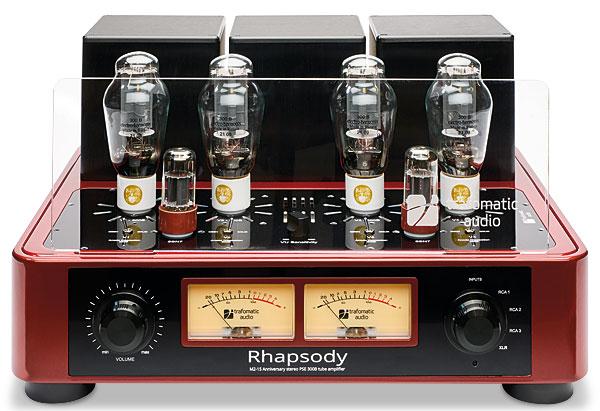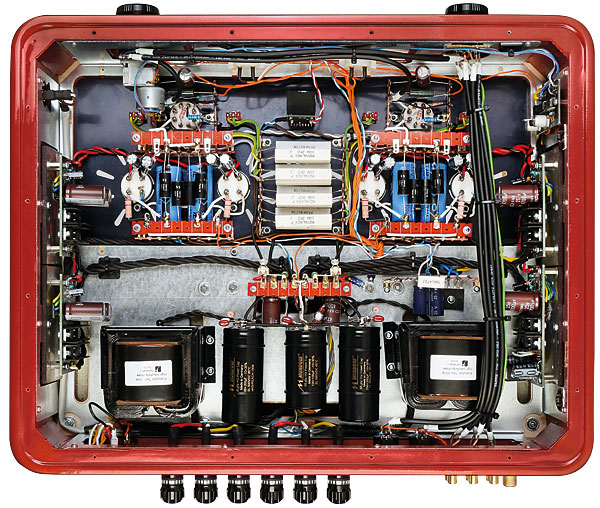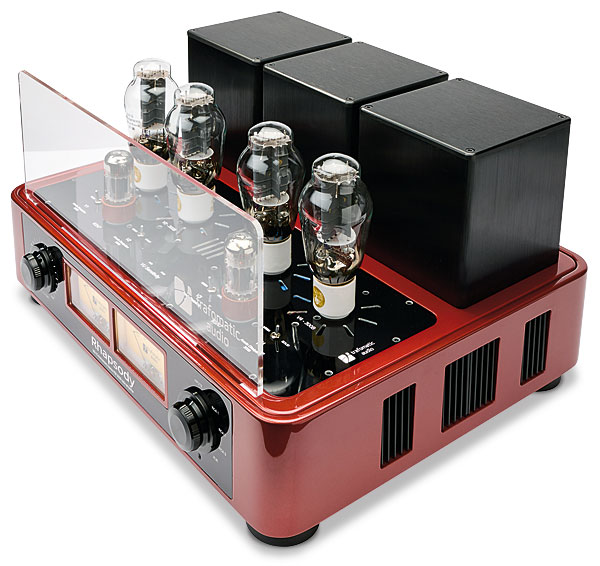Trafomatic Rhapsody Integrated Amplifier

 The latest addition to Absolute Sounds' boutique 'Ten' range – the Trafomatic Rhapsody from Serbia – is a single-ended, 300B-based triode tube amp rated at a mighty 20W
The latest addition to Absolute Sounds' boutique 'Ten' range – the Trafomatic Rhapsody from Serbia – is a single-ended, 300B-based triode tube amp rated at a mighty 20W
As far-fetched as this may seem, given that most post-Millennials have yet to embrace hi-fi, we are living in another audio 'Golden Age'. This isn't the place to rattle off a list of gems that have crossed my path just since the Covid moratorium ended, but the Western Electric WE-91B [HFN Feb '23], a trio of DeVore speakers [HFN Apr '21, Mar & Aug '23], and family of DS Audio optical cartridges [HFN Oct '21 & Oct '23] are among the many that beg my repeating of the homily, 'You've never had it so good'. Trafomatic's Rhapsody (M2-15 Anniversary stereo PSE 300B tube) integrated amplifier joins them, and emphatically so.
Even the £19,998 price surprises: I really thought it would be more. Its physical presence, a brace of 300Bs per channel, a thought-provoking weight of 32kgs, sexy meters, myriad oddly labelled knobs and switches – this is the stuff to make even a jaded audiophile's heart skip a beat. And with it coming from Serbia, I had no idea what it would sound like, despite having seen Trafomatic at numerous shows over the past decade-and-a-half.
Variety Show
The Rhapsody is part of a massive range which includes six power amps, three preamps and two phono stages, eight integrated models of varying topologies including single-ended and push-pull designs, three headphone amps, and a handful of accessories. The variety shows that Trafomatic isn't locked into a single amplifier type, the Rhapsody being a line-level-only 'Parallel Single-Ended' design. Aside from the need to add a phono section if you play vinyl, it's comprehensive by most standards, even including a remote control for playback levels.

Set-up was a no-brainer, aside from one set of toggle switches, which I will get to in due course. Starting at the back, you'll see why, as everything is instinctive. From left to right, there is an earthing post, three pairs of phono sockets (charmingly labelled RCA 1, 2 and 3) and a pair of XLR inputs for a balanced source. The rather fine multi-way binding posts provide for both 4 and 8ohm loads, while to the far right are an IEC socket and a voltage selector. Both sides of the beautifully-finished, metallic vermillion-coloured chassis are louvred, the left side also containing the on/off rocker.
Admiring the VU
Seen from the front, the fascia sports a massive, scalloped rotary knob for volume, which is motorised for the remote. Next are two large, illuminated VU meters. Mirroring the volume control is another black rotary to choose from the three RCA inputs or the one balanced XLR input.
It's the top view that will tickle those who want more than the minimum. Across the back of the Rhapsody are three massive transformers, which – unlike too many – are housed in superbly anodised cases. Next comes the row of four Electro-Harmonix 300B power triodes, one parallel pair per channel, in front of which are two 6SN7s. Inbetween the 6SN7s is a handy knob to adjust the VU meters' sensitivity, which will be useful if you change loudspeakers from say, super-efficient to substantially hungrier and the VU meter readings are either too low, or are continually smacking the end stops at the far right 'red end' of the scales.
What needs further explanation are the four toggles – one per 300B – marked 'Mesh' and 'Solid'. This refers to the type of 300B you are using. As the Rhapsody features auto-biasing, that's not an issue should you wish to change valves. Mesh-vs-Solid is another matter entirely, referring to the type of anode. Mesh anodes handle less power than solid, so a mesh anode valve will be damaged if the switch is set to solid, as for the Electro-Harmonix 300Bs.
Ready To Roll
There's another reason why this valve-swapping facility will endear the Trafomatic to those of a tweaky nature. As you will discover, the Rhapsody does not pray to the 300B SET hymn sheet in every parameter. Yes, it's sweet and warm, but equally it tends toward the more precise and analytical. Look elsewhere for the fat, soft sound used to tame certain horn speakers. Having heard the differences between assorted makes of 300Bs, and as the Rhapsody has no awkward cage to remove, enthusiasts might like to try vintage new-old-stock valves, or splash out on some of the more premium examples available today.

One more thing. Aside from the usual instructions about warm-up, of which a minimum of 15 minutes is recommended, and the owner's manual warning against haste when changing valves, there is another nice touch with safety in mind. Supplied with the unit is a Perspex panel that slots into the front, the two apertures positioned just above each knob on the fascia. This will prevent accidentally bumping into the hot-running tubes. As for space considerations, the footprint is 470x370mm (wd) and it's 260mm tall but the latter is incidental: you will not want anything directly above it.
300B triode amps will never be uber-powerful – the Rhapsody is rated at 2x20W, though PM suggested a much lower real-world figure for mating to speakers. Sensitive speakers like the DeVore O/93s [HFN Mar '23] immediately spring to mind, and these were used for most of my listening, but I did enjoy near-miraculous pairings with my legacy Quad ESL57s, and the far newer PMC prodigy1 [HFN Nov '23] which seemed happy enough in my 12x18ft room.
![]() Rhapsody In Red
Rhapsody In Red
For a forthcoming round-up of audiophile LPs, I have secured a copy of Hit The Bongo! The Latin Soul Of Tico Records [Craft Recordings CR00660], a 2LP set with both mono and stereo tracks. I realise many of you might never bother with mono, but it proves useful when assessing any component, especially if you don't have a mono cartridge or a mono setting on your amp or preamp. You want a rock-solid central image regardless, which the Rhapsody provided. More surprising, however, was the way it handled these incredible, Latin soul and jazz mono tracks, because one soon stopped thinking about the single-channel playback.

















































